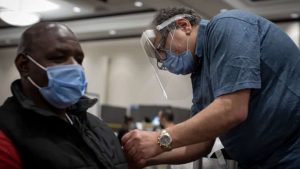Ontario’s control over COVID-19 pandemic improving, modelling says

Ontario’s control over the COVID-19 pandemic is improving due to current public health measures, according to new modelling released by the province’s science advisory table Thursday.
Some non-emergency procedures to restart as Ontario sees fewest COVID-19 cases in 8 weeks
Maintaining progress with vaccinations and maintaining some public health measures until mid-June can “help ensure a good summer,” the modelling states.
It also says that reopening schools will create an increase in cases “but this may be manageable,” and outdoor activities are much safer than indoors and “should be encouraged.”
“The public health measures, no matter how taxing and frustrating, have helped stop the spread,” Adalsteinn Brown, co-chair of the science table, said at Thursday’s news conference.
“If we’re careful and cautious, we can maintain this momentum.”
He added that “hospitals are still under incredible strain.”
Brown said that if the province was to reopen on June 2, it would likely bring a rise in cases with it.
Waiting until the middle of June to start to reopen, Brown said, would lead to a more sustained downward trend in cases.
Certain risks could skew projections
Health Minister Christine Elliott has said any reopening will be done sector by sector, as opposed to the previous colour-coded regional approach.
Brown also noted there are two “critical risks” that could skew these projections — one being a dramatic increase in contacts between people, and the second being the “wildcard risk” posed by a new variant of concern spreading in Ontario.
“We’re encouraged and optimistic, but at the same time, we’re cautious,” Chief Medical Officer of Health Dr. David Williams said Thursday.
The science table’s new figures show per cent positivity for the virus, which is a key metric for monitoring its spread, is declining across Ontario. The report also shows that cases are decreasing in most public health units, with the greatest progress being made in hot spot areas, which had been prioritized for vaccination campaigns.
You can read the full document at the bottom of this story.
Case count dropping week to week
Meanwhile, Ontario reported another 2,400 cases of COVID-19 and 27 more deaths linked to the illness on Thursday.
The total case count is higher than recent days, but more than 350 fewer than last Thursday.
It is best to compare days of the week because testing levels in the province are cyclical. Thursdays often see the most number of new cases and the most tests completed relative to other days.
Today’s infections come as labs processed 45,406 tests and Public Health Ontario logged a provincewide positivity rate of 5.2, the lowest on a Thursday since April 1.
The seven-day average of daily cases fell to 2,131, its lowest point in more than seven weeks.
Another 2,763 infections were marked resolved, bringing the active caseload throughout Ontario to about 23,026.
As of yesterday, there were 1,320 people with COVID-related illnesses in hospitals, 81 fewer than the day before, while 721 were being treated in intensive care. Of those, 492, or about 68 per cent, needed a ventilator to breathe.
The additional deaths reported today pushed the official toll to 8,552. The seven-day average of deaths dropped to 21 from 21.6 yesterday.
Meanwhile, public health units collectively administered another 144,986 doses of COVID-19 vaccines yesterday. As of last night, nearly 58 per cent of Ontarians aged 16 and older have had at least one dose.








Redes Sociais - Comentários